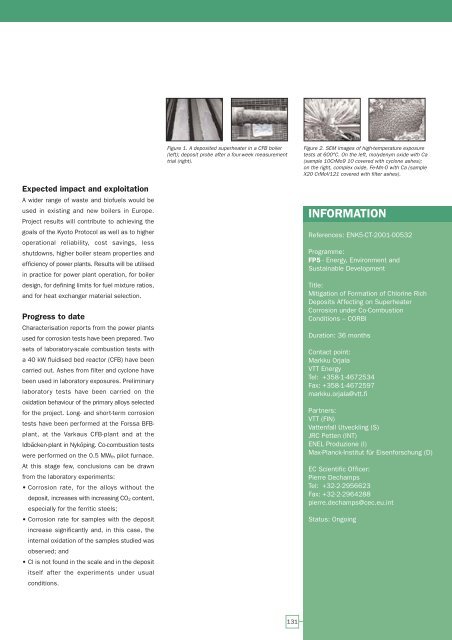European Bio-Energy Projects
European Bio-Energy Projects
European Bio-Energy Projects
You also want an ePaper? Increase the reach of your titles
YUMPU automatically turns print PDFs into web optimized ePapers that Google loves.
Expected impact and exploitation<br />
A wider range of waste and biofuels would be<br />
used in existing and new boilers in Europe.<br />
Project results will contribute to achieving the<br />
goals of the Kyoto Protocol as well as to higher<br />
operational reliability, cost savings, less<br />
shutdowns, higher boiler steam properties and<br />
efficiency of power plants. Results will be utilised<br />
in practice for power plant operation, for boiler<br />
design, for defining limits for fuel mixture ratios,<br />
and for heat exchanger material selection.<br />
Progress to date<br />
Characterisation reports from the power plants<br />
used for corrosion tests have been prepared. Two<br />
sets of laboratory-scale combustion tests with<br />
a 40 kW fluidised bed reactor (CFB) have been<br />
carried out. Ashes from filter and cyclone have<br />
been used in laboratory exposures. Preliminary<br />
laboratory tests have been carried on the<br />
oxidation behaviour of the primary alloys selected<br />
for the project. Long- and short-term corrosion<br />
tests have been performed at the Forssa BFBplant,<br />
at the Varkaus CFB-plant and at the<br />
Idbäcken-plant in Nyköping. Co-combustion tests<br />
were performed on the 0.5 MWth pilot furnace.<br />
At this stage few, conclusions can be drawn<br />
from the laboratory experiments:<br />
• Corrosion rate, for the alloys without the<br />
deposit, increases with increasing CO2 content,<br />
especially for the ferritic steels;<br />
• Corrosion rate for samples with the deposit<br />
increase significantly and, in this case, the<br />
internal oxidation of the samples studied was<br />
observed; and<br />
• Cl is not found in the scale and in the deposit<br />
itself after the experiments under usual<br />
conditions.<br />
Figure 1. A deposited superheater in a CFB boiler<br />
(left); deposit probe after a four-week measurement<br />
trial (right).<br />
131<br />
Figure 2. SEM images of high-temperature exposure<br />
tests at 600°C. On the left, molydenym oxide with Ca<br />
(sample 10CrMo9 10 covered with cyclone ashes);<br />
on the right, complex oxide, Fe-Mn-O with Ca (sample<br />
X20 CrMoV121 covered with filter ashes).<br />
INFORMATION<br />
References: ENK5-CT-2001-00532<br />
Programme:<br />
FP5 - <strong>Energy</strong>, Environment and<br />
Sustainable Development<br />
Title:<br />
Mitigation of Formation of Chlorine Rich<br />
Deposits Affecting on Superheater<br />
Corrosion under Co-Combustion<br />
Conditions – CORBI<br />
Duration: 36 months<br />
Contact point:<br />
Markku Orjala<br />
VTT <strong>Energy</strong><br />
Tel: +358-1-4672534<br />
Fax: +358-1-4672597<br />
markku.orjala@vtt.fi<br />
Partners:<br />
VTT (FIN)<br />
Vattenfall Utveckling (S)<br />
JRC Petten (INT)<br />
ENEL Produzione (I)<br />
Max-Planck-Institut für Eisenforschung (D)<br />
EC Scientific Officer:<br />
Pierre Dechamps<br />
Tel: +32-2-2956623<br />
Fax: +32-2-2964288<br />
pierre.dechamps@cec.eu.int<br />
Status: Ongoing

















